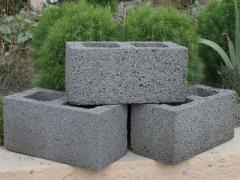 A cinder block foundation is probably the cheapest kind of belt-type bases. The price of cinder block is minimal, and the technology of construction can be mastered by any builder, even a beginner.
A cinder block foundation is probably the cheapest kind of belt-type bases. The price of cinder block is minimal, and the technology of construction can be mastered by any builder, even a beginner.
A method of production of cinder blocks
Typical cinder blocks are usually made of a mix consisting of a dry part (that consists of sand, cement, slag dump or brick battle) and water. Building a cinder block foundation a consumer of these products solves two problems at once: it helps to dispose of secondary raw materials (non-toxic waste of any kinds of production) and reduces the cost of building materials.
The first step in the production of cinder blocks is to mix the ingredients together. Cement, water, and aggregates are combined in a mixer until a homogenous mixture is formed. The amount of water added to the mix is critical, as too much water will weaken the strength of the blocks, while too little water will make the mixture too dry to mold. The mixture is then poured into molds and compacted to remove any air pockets.
After the molds are filled, the blocks are then left to cure, or harden. This process can take several days, depending on the type of cement used and the temperature and humidity conditions. During the curing process, the blocks will be kept in a controlled environment, such as a curing chamber, to ensure that the blocks have the correct amount of moisture for the curing process to be effective. Once the curing process is complete, the blocks are removed from the molds and are ready for use in construction projects.
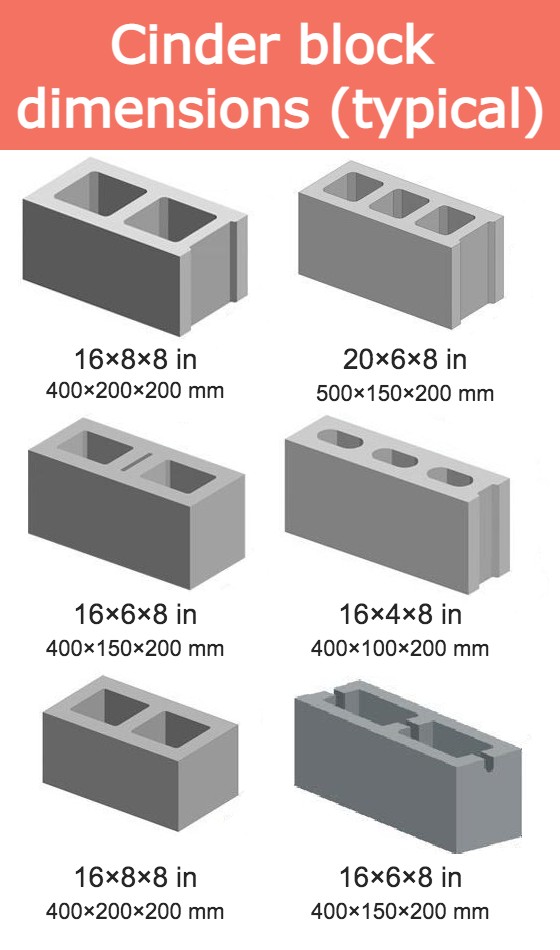
Cinder block dimensions
The standard size of a cinder block, is 8×8×16 inches (length, width, height). The Foundation block dimensions are usually corresponds to сinder block dimensions. However, it’s important to note that the standard size of a foundation block may vary depending on the building codes of the area, the type of foundation, and the structural requirements of the building. Some foundation blocks can be as large as 24 inches long, 16 inches wide and 8 inches high, and they are used in areas that require extra strength and stability.
We recommend to consult with a professional engineer or a building code official to ensure that the foundation block size you are using is appropriate for your specific project, and that it complies with the local building codes and regulations.
Advantages and disadvantages of a cinder block foundation
- Cheapness – the building material consists of waste by half or even more;
- Durability – this type of a foundation can withstand up to 100 tons;
- Frost-resistance – hollow block keeps the body even better than products made of foam;
- Size advantage – due to its relatively small weight and size a cinder block, being however large enough, makes the construction process faster than similar work based on laying bricks or installation of concrete products.
Disadvantages:
- Insufficient hydrophobicity – such unit absorbs moisture from soil and atmosphere; this may affect the durability of the product in quite a negative way;
- The high thermal conductivity of monolithic products – the entire unit, with its voids, can not prevent the unwanted heat transfer between the heated room and the street;
- Insufficient strength in the transverse direction – sometimes it can not hold a transverse load in a proper way.
Building a cinder block foundation
Attention! The walls of the basement should be insulated without fail (even if the building will be erected on dry ground). It is necessary not only to protect the vertical plane of cinder blocks, but also to lay a horizontal layer between the underground and above-ground parts of the building. This helps to prevent the extra moisture of house walls because of capillary moisture.
 Laying the base is only possible on relatively dry soils with low levels of underground waters and the shallow depth of soil freezing. In addition, a cinder block foundation can not be built on clay (or similar) grounds. The reason for this is lack of lateral stability.
Laying the base is only possible on relatively dry soils with low levels of underground waters and the shallow depth of soil freezing. In addition, a cinder block foundation can not be built on clay (or similar) grounds. The reason for this is lack of lateral stability.
So, if your site is in a zone of deep groundwater or soils containing no unnecessarily moving beds, the construction is following.
First, you should dug trenches for tape bases or settle pits for columnar ones. Then, on the bottom of the trenches or the pits pour a layer of sand and gravel. Spread prepared roofing paper for waterproofing of your foundation bottom. On a layer of roofing material a precast concrete block can be installed, or pour a reinforced sole (4*4 inches grill), then concrete it. After the arrangement of the foot on the concrete you should lay the first row of blocks (in case of construction of the tape base) or the first layer of blocks (in case of the construction of the columnar base). A subsequent row/layer is placed from the corners to the center, connecting the upper and lower layers with rather thin (less than 0,5 inch) layer of bonding solution. This operation is repeated until the completion of the needed height. The upper part of your foundation should be made of reinforced concrete, wood or metal. At the end the walls of the basement are usually covered with a layer of mastic, and the finishing step is, for sure, covering styrofoam panels. You can then fill the pit and go to the construction of the wall structure of your house.
Now your cinder block foundation is ready! The proper exploitation will let it serve you well for long decades.
Cinder block foundation problems
Cinder block foundations are a common type of foundation used in residential construction. However, they can also be prone to a number of problems if not properly constructed or maintained.
One common issue with cinder block foundations is cracking. Cracks can occur due to a variety of factors, including settling of the foundation, soil movement, and changes in moisture levels. These cracks can allow water to seep into the foundation, leading to further damage and potential structural issues. Additionally, if the cracks are large enough, they can also create drafts and make the home less energy efficient.
Another problem that can occur with cinder block foundations is efflorescence. This is a white, powdery substance that can appear on the surface of the blocks. It is caused by water seeping through the blocks and carrying dissolved minerals to the surface. Efflorescence is not only unsightly, but it can also indicate that water is penetrating the foundation, which can lead to further damage if left unaddressed.
It is important to regularly inspect cinder block foundations for any signs of cracking or efflorescence, and address any issues as soon as they are identified. Preventive maintenance, such as ensuring proper drainage and grading around the foundation, can also help to minimize the risk of problems. If you suspect that your cinder block foundation may have issues, it is important to consult with a professional to have it inspected and any necessary repairs made.
Questions and answers on the cinder block foundation
Q: Do cinder blocks make a good foundation?
A: Cinder blocks, can be a suitable foundation option for certain types of buildings and under the right conditions. However, it’s important for professionals to take into account the specific structural requirements of the building, including the load-bearing capacity and soil conditions. Cinder blocks offer advantages such as being affordable and easy to find, as well as being strong and durable.
However, they may not be suitable for certain types of structures, such as those with heavy loads or in areas with high soil movement. It’s also important to ensure that the cinder blocks are properly reinforced and installed to provide a stable foundation. Additionally, it’s best to check local building codes and consult with a structural engineer to ensure the foundation design meets the necessary safety and structural standards.
Q: How long do cinder block foundations last?
A: The lifespan of a cinder block foundation depends on several factors, including the quality of the materials and workmanship used during construction, the soil conditions, and the maintenance of the foundation over time. Typically, cinder block foundations that are properly constructed and maintained can last for many decades.
However, it is important for professionals to regularly inspect the foundation for signs of wear and tear, and address any issues that may arise to ensure the longevity of the foundation. It’s also important to keep in mind that foundation repair or replacement may be necessary over the life of a building, regardless of the type of foundation used.
Q: Is cinder block or poured foundation better?
A: The choice between a cinder block foundation and a poured concrete foundation depends on several factors, including the type of structure, the soil conditions, and the cost of the materials and labor. Both cinder block and poured concrete foundations can be strong and durable when properly constructed and maintained.
Cinder block foundations are typically less expensive to install, and are suitable for smaller structures. Poured concrete foundations, on the other hand, can be more versatile and can be customized to the specific needs of the building and soil conditions, and can be particularly suitable for larger structures and buildings with heavy loads.
Q: Why are houses not built with cinder blocks?
A: While cinder blocks can be a suitable foundation option for certain types of buildings and under the right conditions, they are not as commonly used for residential construction for several reasons. Cinder blocks are typically larger and less refined than other types of building materials, which can make them less visually appealing for residential construction.
Additionally, cinder blocks are typically less energy efficient than other types of building materials, which can increase heating and cooling costs for homeowners. Furthermore, cinder blocks may not be suitable for certain types of structures, such as those with heavy loads or in areas with high soil movement. Poured concrete foundations, wood frame, and masonry are more popular choices for residential construction.
Q: Do cinder blocks count as permanent foundation?
A: Cinder blocks can be considered as a permanent foundation as long as they are properly reinforced and installed, and meet the local building codes and regulations. A permanent foundation is a type of foundation that is anchored to the ground and cannot be moved or disassembled.
The use of cinder blocks for permanent foundation is a common practice, but it’s important to keep in mind that the building codes and regulations may vary by location. Additionally, cinder blocks may not be suitable for certain types of structures, such as those with heavy loads or in areas with high soil movement.
Q: How long will a cinder block foundation last?
A: The lifespan of a cinder block foundation depends on several factors, including the quality of the materials and workmanship used during construction, the soil conditions, and the maintenance of the foundation over time. Typically, cinder block foundations that are properly constructed and maintained can last for many decades.
However, it is important for professionals to regularly inspect the foundation for signs of wear and tear, such as cracking, settling or water infiltration, and address any issues that may arise to ensure the longevity of the foundation. It’s also important to keep in mind that foundation repair or replacement may be necessary over the life of a building, regardless of the type of foundation used.
Q: Why are houses in Florida made of cinder blocks?
A: Cinder blocks, are commonly used in Florida as a building material for residential construction due to their durability and resistance to natural hazards such as hurricanes and flooding. Cinder blocks are made of concrete and aggregate materials, making them strong and able to withstand high winds and heavy rain. Additionally, cinder blocks provide good insulation, which can help to keep the interior of the house cool, this is an advantage in the hot and humid climate of Florida. Furthermore, cinder blocks can be an affordable building option and easy to find in the area, which makes them a popular choice for residential construction. However, it’s important to keep in mind that cinder block foundations may not be suitable for certain types of structures, such as those with heavy loads or in areas with high soil movement.
Q: Do cinder block foundations need insulation?
A: Cinder block foundations, like any other type of foundation, will benefit from insulation to prevent heat loss and to increase energy efficiency. Insulating the foundation can help to keep the interior of the building warm in the winter, and cool in the summer. Additionally, insulation can also prevent moisture from entering the building, which can reduce the risk of mold and mildew.
However, the insulation requirements for cinder block foundations may vary based on the local building codes and climate conditions. In cold climates, it is often required to insulate the perimeter of the foundation to prevent heat loss and to comply with energy efficiency codes. In hot climates, insulation is usually not required, but it may be added to keep the interior of the house cool and to reduce energy costs.
It’s best to check with local building codes and consult with a structural engineer to determine the appropriate insulation requirements for a specific building project. In the absence of such an opportunity, you can explore the foundations of buildings similar to yours in the district.
Q: What is the standard size of a cinder block?
A: The standard size of a cinder block, also known as a concrete block or breeze block, is 8 inches long, 8 inches wide, and 16 inches high. This size is known as a “full” block and is the most commonly used size in construction projects. However, cinder blocks can also come in other sizes such as 4 inches high (half-block) or 12 inches high (2-block). It’s important to note that the size of the cinder block may vary depending on the manufacturer or location.
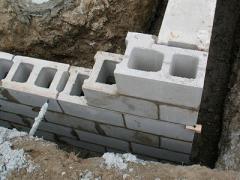
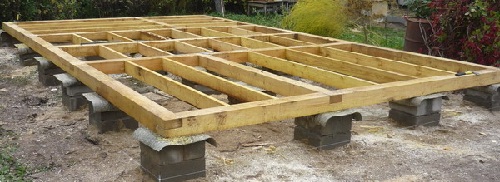
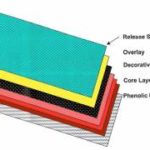
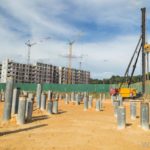

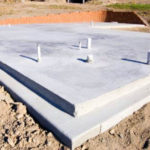
How to build a cinder block foundation